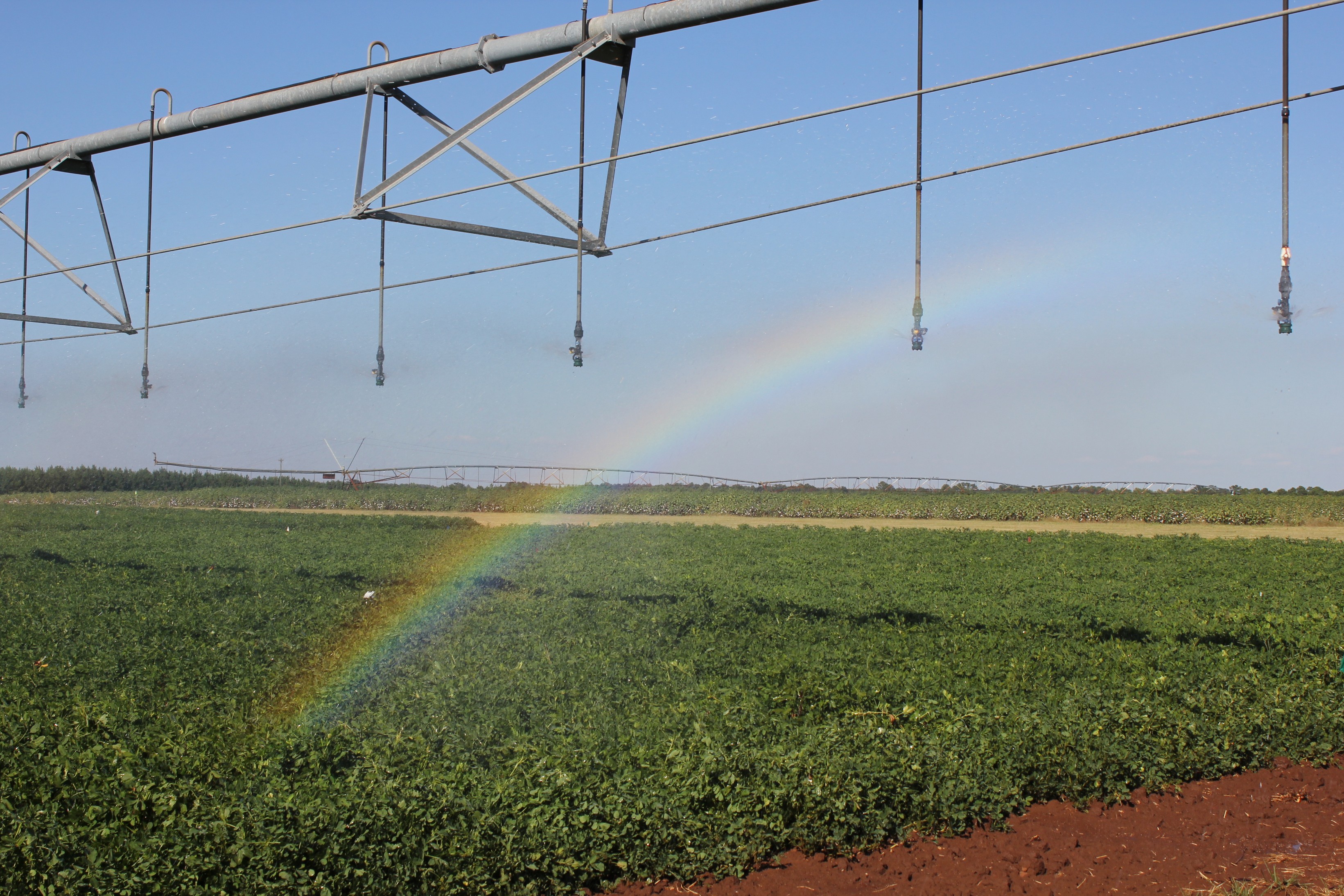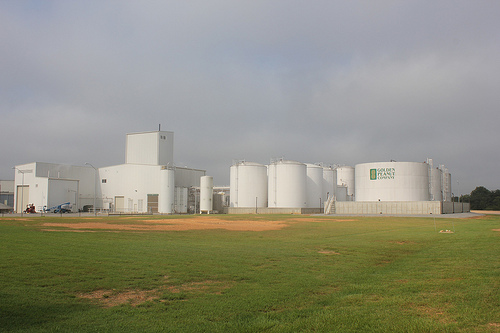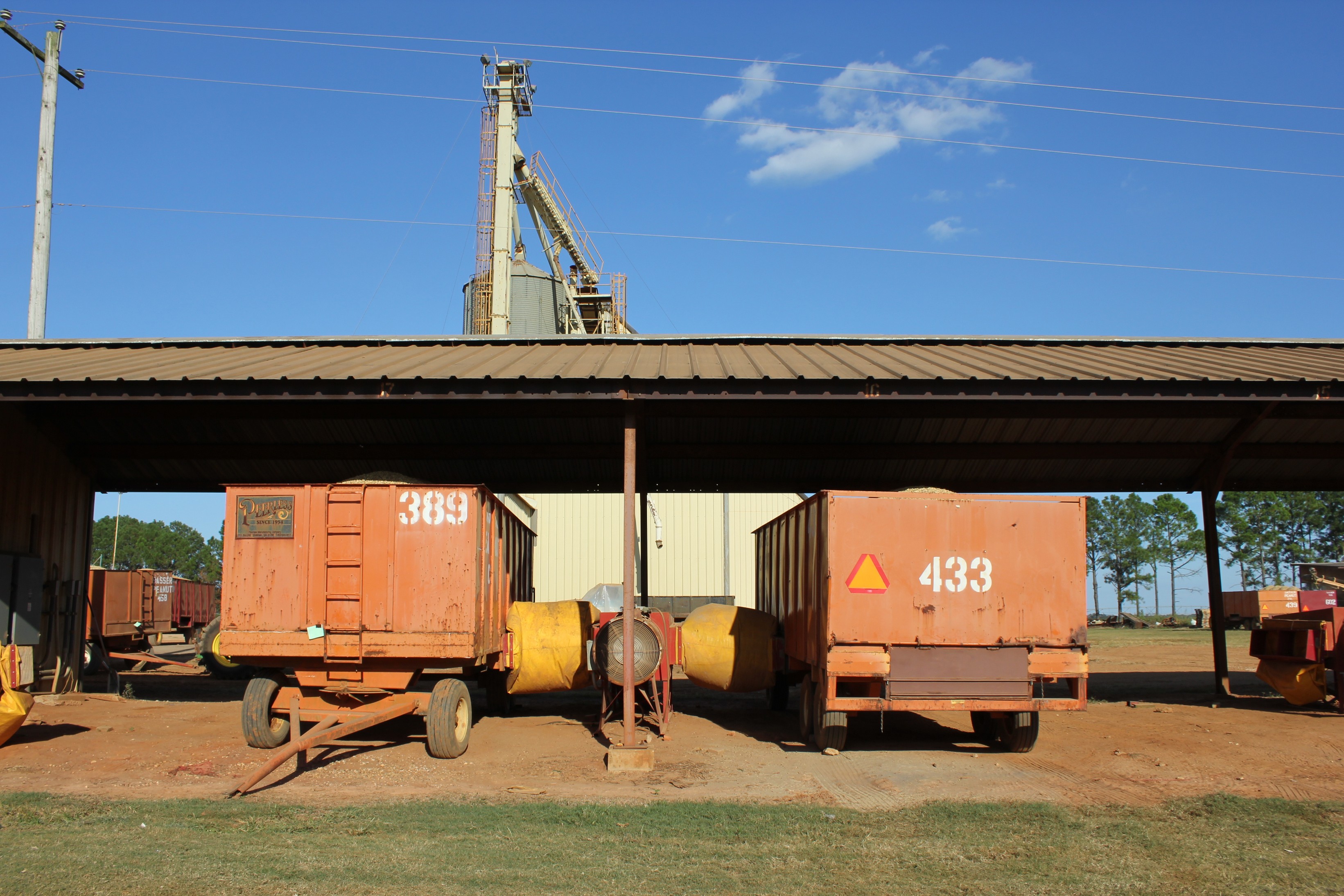Some of you may be wondering, “Who is behind all the blog posts for the Georgia Peanut Tour?” This year the photos, video and blog posts were coordinated by Joy Carter, director of communications for the Georgia Peanut Commission (GPC), and Kirsten Underwood, GPC communications intern. Thanks to all of you for making our job so easy. And a special thanks to Sandra and Rebecca for driving us around. Having a driver where we could update blog posts, twitter and facebook on the road made it a little faster. Throughout the tour we took many photos but I (Joy) wanted to share one photo with you that is my favorite photo of the 2010 Georgia Peanut Tour. The photo below was taken during the tour of the USDA-ARS National Peanut Research Lab in Dawson, Ga. We wish you a wonderful year and hope to see you again next year for the 25th Annual Georgia Peanut Tour.
2010 Georgia Peanut Tour
Kirsten Underwood performs “Back Home in Georgia”
Good food, Southern charm and sights, as well as friends for life are all items that make the Georgia Peanut Tour so special. The last night was no different and included all of the above plus live entertainment from local performing artist Kirsten Underwood of Ty Ty, Ga. Underwood is no stranger to the peanut industry since her grandmother has worked at the Georgia Peanut Commission for more than 30 years. Underwood is currently serving as the communications intern at the Georgia Peanut Commission and she assisted with the production of the earlier posts on the tour blog. Check out the video below of Kirsten performing one of her original songs “Back home in Georgia” during the Georgia Peanut Tour.
RIP Clayton Holton – “The question man”
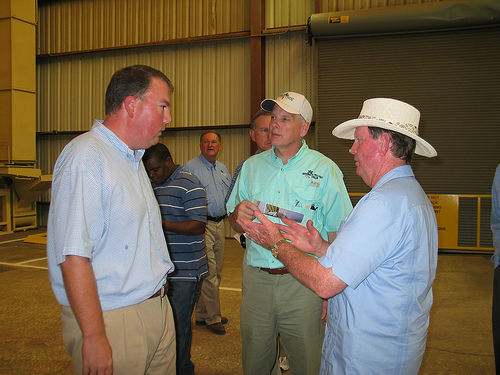
Clayton Holton (right) visits with Scott Angle (center), UGA College of Agricultural and Environmental Sciences dean, and Joe West (left), executive vice president of McCleskey Mills, during the 2008 Georgia Peanut Tour.
For those who attend the Georgia Peanut Tour annually, they noticed one individual missing this year. That individual, Clayton Holton, attended the tour every year and always had a questions ready for each tour stop. Unfortunately, Holton passed away a couple of weeks before the tour on Friday, September 3, 2010 at his residence. He resided in Murphy, N.C. He was a native of Dougherty County, Ga. and was a member of the National Peanut Research Association and one of the first certified crop advisors in Georgia. He had a great knowledge of geography. Clayton was man of the year in Soil and Water Conservation Flint River Soil and Water Conservation District. Clayton enjoyed farming, horses and traveling the mountains. This year on the peanut tour, his wife – Sharon and nephew – Rob, attended the tour to carry out one tradition that was so important to Clayton. According to Sharon, Clayton loved the Georgia Peanut Tour for many reasons including:
1. He could learn from all the latest research that the scientists are proving and sharing!
2. He could meet interesting people such as the lady who had her own combine!
3. He could learn new techniques from growers in the field.
4. He could learn new strategies for farming more economically.
5. He could learn the newest Peanut Varieties and their strengths.
6. He could enjoy the comraderie with other people who had interest in feeding more of the world’s hungry with quality food.
7. He could share funny stories.
The reasons Clayton loved attending the tour annually are most likely some of the same reasons many individuals attend today. The tour provides an outlet for learning about the peanut industry but it also provides an avenue for meeting life-long friends in this wonderful industry. Clayton, you will be greatly missed but not forgotten.
Irrigation plays a key role in the success of a peanut crop
Most peanut farmers will agree that their best insurance policy is irrigation. In a hot, dry year like this year, irrigation is the the key to the success of producing a profitable peanut crop. Donald Chase of Chase Farms in Macon County, Ga., talks about their irrigation program in the video below.
Predicting peanut maturity
The 2010 Georgia Peanut Tour stopped at the National Peanut Research Lab in Dawson, Ga. Established in 1965, the lab focuses on and improving farm practices such as better planting and irrigation practices, better harvesting and storage methods, and better control over aflotoxin. While touring the research center tour attendees learned more about determining maturity of peanuts by using growing degree days and irrigator pro to schedule irrigation. Wilson Faircloth, research agronomist with the lab, explains more in the video below.
How is Peanut Oil made?
The Georgia Peanut Tour visited the largest employer in Dawson, Ga. – the Golden Peanut Company Oil Mill. The oil mill operation began in 2007. The plant in Dawson, Ga., is 100 percent peanut oil and the largest customers are Ventura Foods (LouAna), Chick-fil-A and Smuckers. Peanut oil is very seasonal because of turkey frying with peanut oil so after July the plant is running at full speed. The oil mill is fully automated with three steps for making peanut oil: 1. Refining, 2: Bleaching and 3: Deodorization. The steps, RBD, are very common steps for manufacturing all oils. Refined Peanut Oil is a highly stable allergen free* and trans fat free cooking oil that has a pleasant flavor. Refined Peanut Oil is very low in saturated fats and is a popular oil for frying applications due to its high smoke point.
Peanut Tour visits Sasser 520 Peanut Buying Point
The Georgia Peanut Tour visited Sasser 520 Peanut Buying Point so attendees could learn more about the first point of delivery for peanuts after harvest. Farmers haul their peanuts in wagons or semi trailers to the buying point. Prior to delivery the farmer tags the load in the field. The tag contains the producer’s name, farm and variety information. Once at the buying point the peanuts are dryed in the wagons and then a sample is removed from the wagon for grading. The grading is handled by the Georgia Federal State Inspection Service. The peanuts are stored in warehouses and then hauled to shellers for additional processing.
Learn more about shelling peanuts at McCleskey Mills
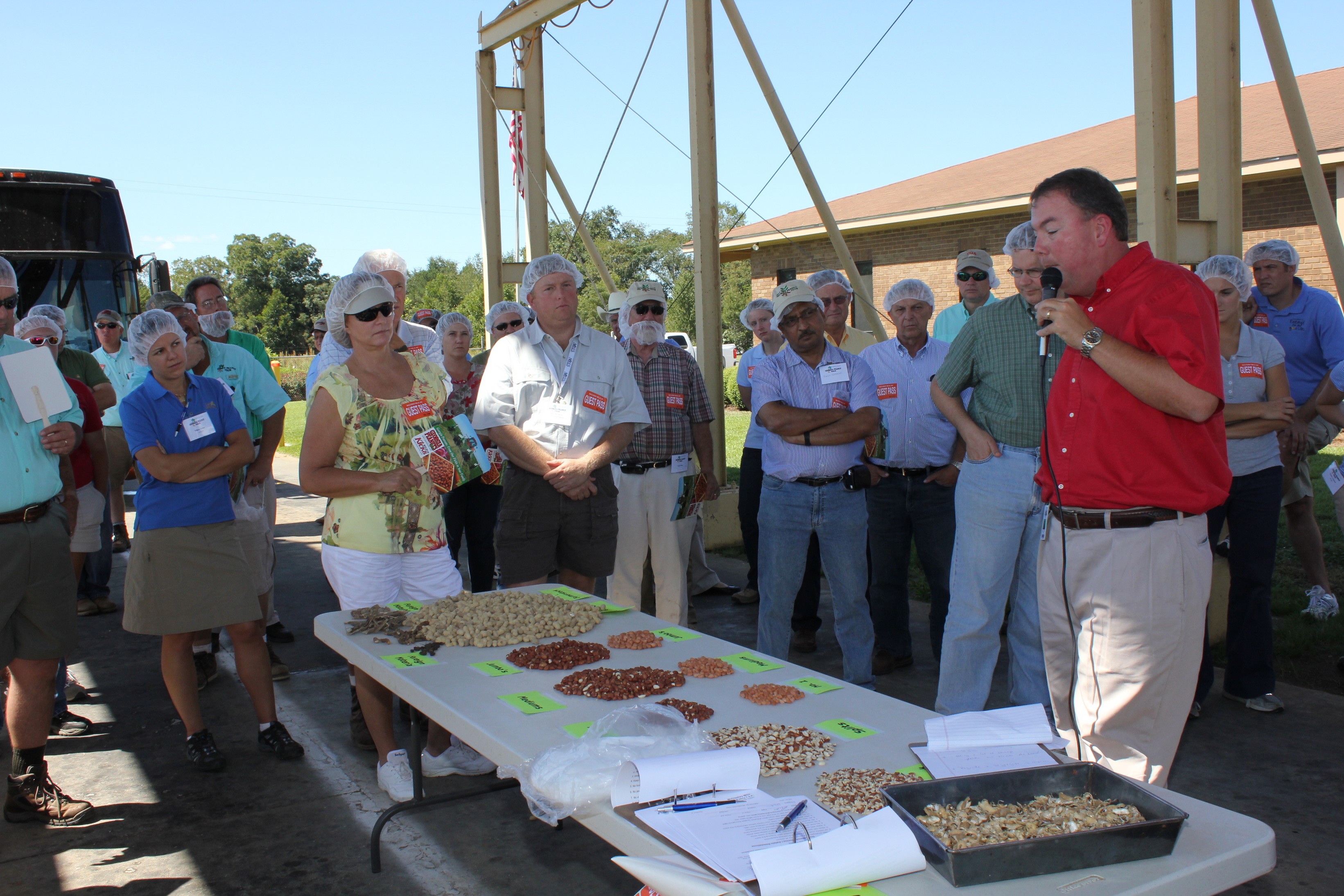
Joe West, executive vice president of McCleskey Mills, explains how peanuts are sorted at the shelling plant.
The Georgia Peanut tour visited McCleskey Mills in Smithville, Ga. McCleskey Mills is a family owned operation that shells about 100,000 tons of farmerstock peanuts annually which is generated by 15 buying stations in Georgia, Florida and Alabama. The three shift operation provides a portion of the needs for the world’s major peanut butter, candy, confectioners, as well as salted nut roasters. Many of their buyers include Smuckers Company (Jif), Mars, Skippy, Peter Pan, Hershey Company, Best Foods, Kroger and Algood Foods. Being home-owned and managed, McCleskey is able to make on-the-spot decisions and offers its’ grower customers competitive markets, and manufacturer customers the industry’s highest quality shelled peanuts in bags, boxes or bulk containers. The company’s seed peanut program grows and distributes high quality seed in the Southeast, and enjoys a reputation second to none. This was a great stop for the Peanut Tour for group members were able to see what happens to the peanut crop once it leaves the farm and enters a shelling plant. Thanks to McCleskey Mills for all that they do for the ever growing peanut industry!
Webster and Taylor Counties Ag Update
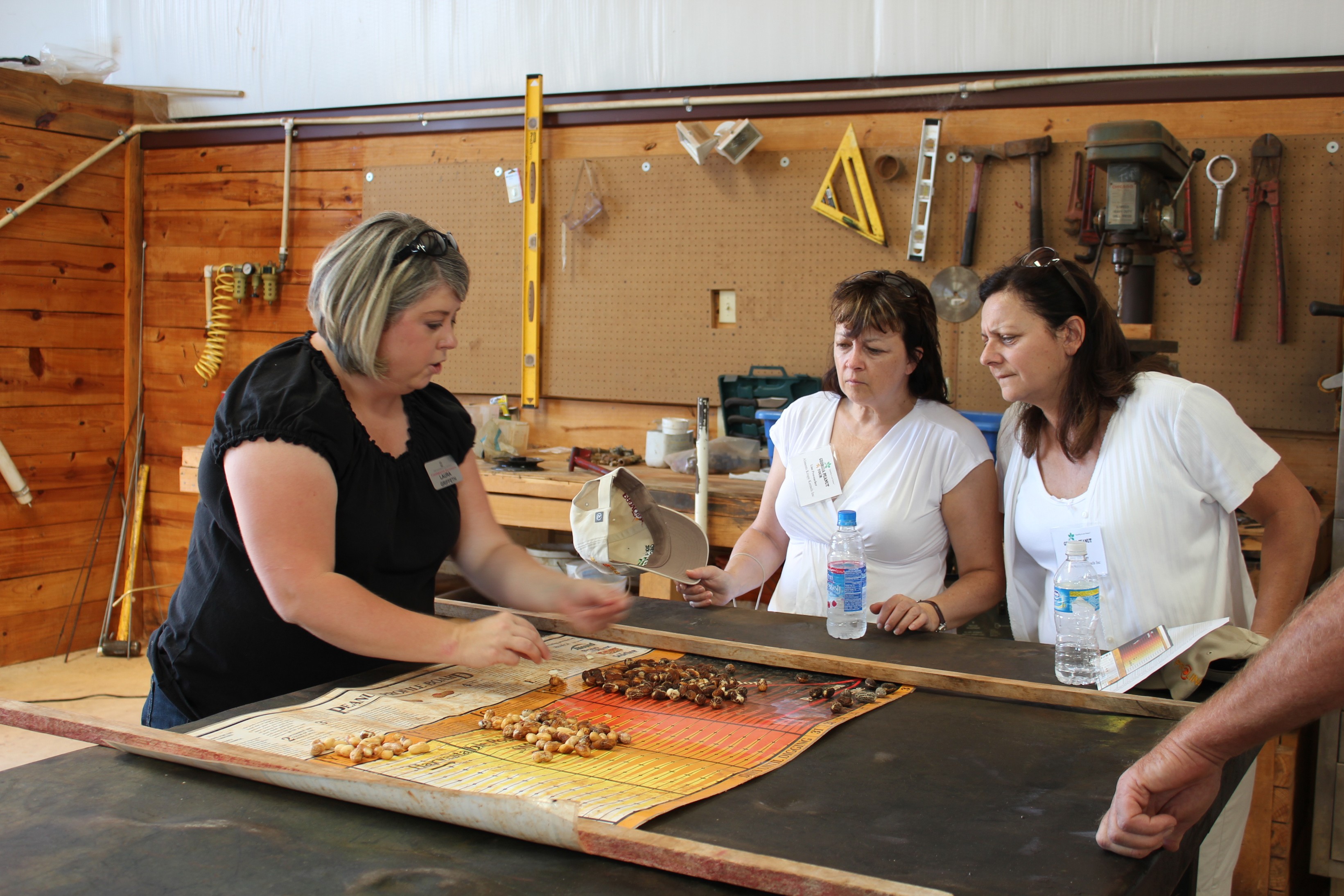
Laura Griffeth, Webster County Extension coordinator, explains how farmers use the profile board to determine when peanuts are ready for harvest.
Webster County Extension Update
Laura Griffeth, Webster County Extension Coordinator, says farmers in Webster County have had major issues with drought and weed control this growing season. There has also been an increase in the amount of insects this year. Farmers planted 5,630 acres of peanuts with approximately 60 percent planted on dryland and 40 percent on irrigated land. Cotton is the major crop grown in Webster County, but peanuts and cattle fall right in behind.
Taylor County Extension Update
Jeff Cook, Taylor County Extension Coordinator, says the peanut crop in the county looks good this year. Peanut acreage in Taylor County ranges from about 1,500 to 2,000 acres and the county produces more peaches than peanuts. Farmers have faced issues in the middle of the growing season with heat and drought and are expected to produce 3,000 pounds per acre. Taylor County also produces cattle, poultry, and other row crops.
Sumter County Ag Update
Sumter County Extension Coordinator, Bill Starr, updated the Georgia Peanut Tour group on the peanut crop in Sumter County. Farmers in Sumter County planted 10,000 acres of peanuts this year and they have faced many challenges including the heat and drought. The big question this year that is still up in the air is the expected yield for peanuts. Starr says that some of the irrigated peanuts look good but the dryland peanuts are all over the board and he expects the yield to be lower than last year. Most of the peanuts in Sumter County are grown on twin rows. Approximately 70 percent of peanuts planted are irrigated and 30 percent are dryland. Other crops grown in Sumter County are cotton, soybeans, vegetables, and turf. Sumter County also grows more snapbeans than any other county in Georgia. Watch the video below of Bill Starr to learn more about agriculture in Sumter County.


